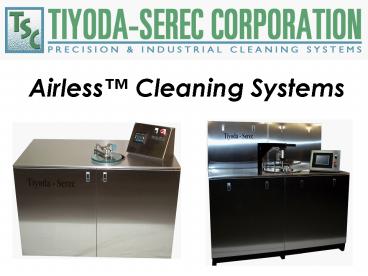Airless Cleaning Systems - PowerPoint PPT Presentation
1 / 19
Title: Airless Cleaning Systems
1
- Airless Cleaning Systems
2
TSC Airless Cleaning Systems
- TSC Airless Cleaning Systems are distillable
solvent cleaning systems where the process occurs
in a vacuum chamber for the ultimate in
efficiency, performance and environmental
responsibility. - TSC Airless units can address applications of
all sizes. - TSC Airless units provide the lowest utility
consumption, highest repeatability, lowest
environmental impact and lowest operational cost
of any cleaning process. - TSC Airless systems accommodate virtually all
common distillable chemistry cleaning agents.
3
TSC Airless Applications Benefits
- Applications
- Aerospace
- Tube Cleaning
- Bearings
- Castings
- Dewaxing
- Electronic Assemblies
- Machined Parts
- Medical
- Optics Photonics
- Powdered / Sintered Metals
- Screw Machined Parts
- Semiconductors
- Benefits
- Clean Dry Parts
- Near Zero Emissions
- Closed Loop Design
- Exceeds EPA / OSHA Regulations
- Saves Solvent
- Easy To Maintain
- Multi Solvent Compatibility
- Low Utility Consumption
4
TSC Airless Processing Options
- Ultrasonic cavitation
- 360O spray impingement
- Filtration
- Multiple process chambers
- Integrated automation
- Part rotation or tumbling within process chamber
- Auxiliary distillation
- Integrated chiller boiler (available as
required)
5
TSC Airless Compatible Solvents
- HFCs (DuPont Vertrel)
- HFEs (3M Novec Fluids)
- n-propyl bromide
- HCFCs (AK-225)
- Chlorinated solvents (trichloroethylene,
perchloroethylene, methylene chloride) - Azeotropes blends
- Hydrocarbons
- Isopropyl alcohol
- Combustible flammable solvents
6
TSC Airless Process Description
- Loading of the parts
- Decompression, (air removal)
- Warm solvent soak (static, recirculating
cleaning) - Warm solvent ultrasonic cleaning (optional)
- Cold solvent soak (static, recirculating rinsing)
- Cold solvent ultrasonic cleaning (optional)
- Vapor cleaning
- Vacuum drying vapor removal
- Scavenging (final air purge)
- Unloading of the parts
7
TSC Airless Configurations
- Horizontal Loading (front loader)
- Vertical Loading (top loader)
8
More Airless Configurations
- Multiple process chambers
- Very large or custom size/shape process chambers
available
9
More Airless Configurations
- Horizontal Pizza Oven chamber
- Tube cleaner
10
ACS1212 Cabinet Model
- Cost effective
- 1 cubic foot top loader
- Totally vacuum sealed
- Co-solvent capable
- Built- in distillation
- SCAQMD permitable
- Small footprint
- Ideal for cleanrooms
11
ACS1212 Cabinet Model
Optional Cleanroom Enclosure
12
ACS1212 Process Flow
13
Series 2200 Airless
- Cost effective
- 3 cubic foot top loader
- Totally vacuum sealed
- Co-solvent capable
- Built- in distillation
- SCAQMD permitable
- Small footprint
14
Series 1000 Airless
- Very cost effective
- 10 x 12 top-loading chamber
- Totally vacuum sealed
- Co-solvent capable
- Built- in distillation
- SCAQMD permitable
- Very small footprint
- Minimal utility / facility requirements
15
Aerospace Cleaning System
16
Typical Industrial Cleaner Configuration
- Typical cycle time 20 minutes (or less)
- Working chamber 24D X 24L (or 24 inches3)
- Footprint 96 by 72 by 66
- Approximate emissions for trichloroethylene are
18 to 20 lbs. per 1000 cycles - Requires chilled water at 12 GPM with a ?T of
20OF (in _at_ 45OF, out _at_ 65OF) - Requires 150,000 BTU/Hour _at_ 15 PSIG steam. (apx
48 kW steam) - Requires 15 kW electrical
17
Benefits Of Vacuum Technology
- Solvent Emission Reduction Initially the air in
the cleaning chamber is evacuated so that the
solvent and the air are not interfaced with each
other to eliminate the solvent emissions. - De-gassing the Solvent When the solvent is
placed under vacuum, the air dissolved in the
solvent is eliminated to enhance the ultrasonic
power this means cleaner parts. - Drying the Parts Completely In the vacuum drying
process, the vacuum created in the cleaning
chamber depresses the boiling point of the
solvent becoming 75 of its boiling point at
atmospheric pressure. The higher the vacuum, the
lower the solvent boiling point. The heat
capacity of the parts helps boil the solvent and
the evaporated vapor is recaptured and recycled
in the system.
18
Open Top vs. Airless
19
342 Compass Circle North Kingstown, RI
02852 Phone 401-667-7370 Toll-free
1-866-298-0098 Fax 401-667-7375 sales_at_tiyoda-serec
.com www.tiyoda-serec.com































